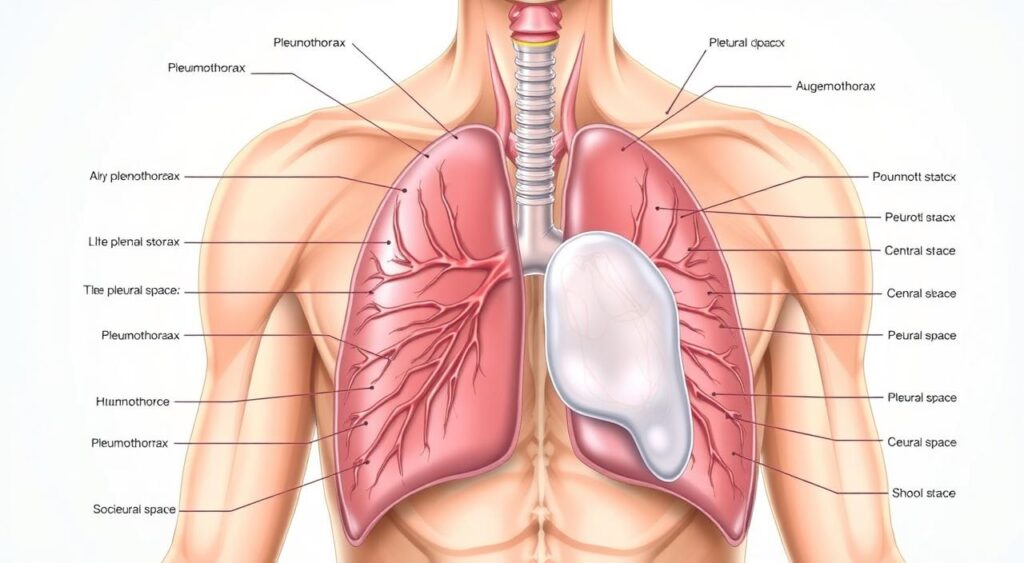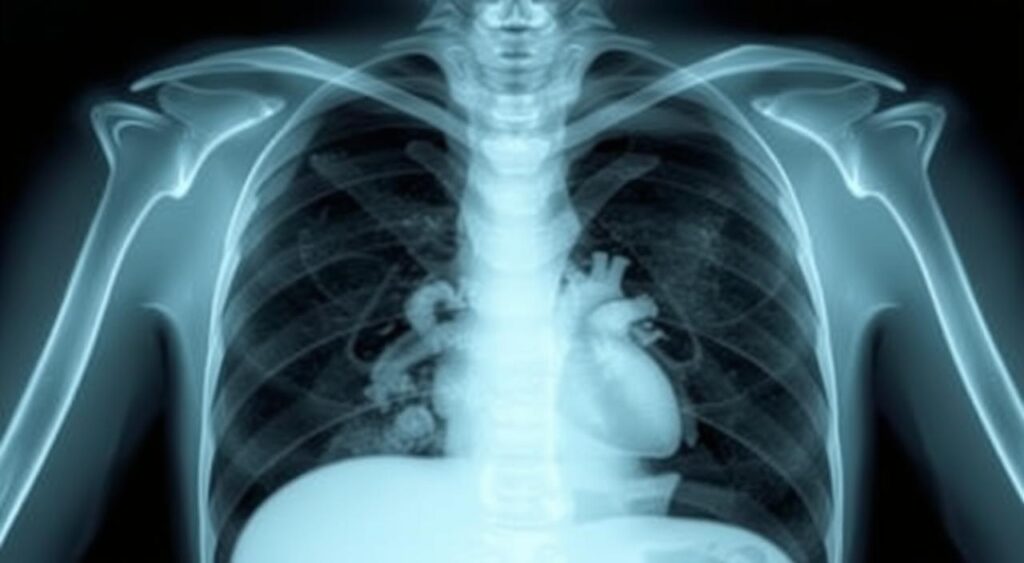Did you know a single punctured lung can collapse the whole respiratory system? This is a serious issue. Air leaks into the space between the lung and chest wall, causing the lung to collapse. It’s vital to understand pneumothorax to keep our lungs healthy.
This guide will explore pneumothorax in detail. We’ll look at its types, anatomy, causes, and symptoms that need quick medical help. We’ll also discuss how to diagnose and treat it, helping you get back to good health.

Key Takeaways
- Pneumothorax is a serious condition where air leaks into the space between the lung and chest wall, causing the lung to collapse.
- It can have various causes, including trauma, underlying lung diseases, or spontaneous events.
- Recognizing the symptoms, such as sudden chest pain and shortness of breath, is crucial for seeking prompt medical care.
- Diagnostic procedures, including imaging tests and physical examination, help identify the type and severity of pneumothorax.
- Emergency treatment, such as chest tube insertion, and long-term management strategies are essential for restoring respiratory health.
Understanding Pneumothorax and Its Impact on Respiratory Health
Pneumothorax is a condition where air gets trapped in the space between the lung and chest wall. This can make the lung collapse. It greatly affects breathing and overall health.
Types of Pneumothorax
There are several types of pneumothorax, each with its own causes and characteristics:
- Spontaneous pneumothorax: This occurs without any known external cause, often in individuals with underlying lung conditions or structural abnormalities.
- Traumatic pneumothorax: This is caused by a chest injury, such as a puncture wound or rib fracture, that allows air to enter the pleural space.
- Tension pneumothorax: A severe and life-threatening type of pneumothorax where the air continues to accumulate in the pleural space, putting increasing pressure on the lung and other organs.
The Anatomy of Lung Collapse
The pleural space is a tiny, fluid-filled gap between the lung and chest wall. It allows the lung to expand and contract during breathing. In a pneumothorax, this space is filled with air. This causes the lung to collapse and impairs pulmonary function.
This can lead to symptoms such as chest pain, shortness of breath, and pleural effusion. Excess fluid accumulates in the pleural space.
| Type of Pneumothorax | Cause | Impact on Respiratory Health |
|---|---|---|
| Spontaneous | Underlying lung conditions or structural abnormalities | Partial or complete lung collapse, impaired breathing |
| Traumatic | Chest injury, puncture wound, or rib fracture | Rapid air accumulation in the pleural space, potentially life-threatening |
| Tension | Severe, uncontrolled air accumulation in the pleural space | Increased pressure on the lung and other organs, potentially fatal if not treated promptly |
Understanding the different types of pneumothorax and how they affect the lungs is key. It helps recognize warning signs and seek timely medical help. This prevents further complications and protects respiratory health.
Common Causes and Risk Factors of Pneumothorax
Pneumothorax is when air gets trapped between the lungs and the chest wall. Knowing what causes it helps in preventing and treating it.
Chest trauma is a big cause. This can happen from accidents, injuries, or surgery. A car crash or a fall can hurt the lung and cause air leaks. Also, penetrating chest injuries like stab wounds can damage the lung and lead to pneumothorax.
Lung diseases also play a role. Conditions like chronic obstructive pulmonary disease (COPD), asthma, and lung cancer can weaken the lungs. This makes them more likely to get air leaks and pneumothorax.
Other things can increase the risk of pneumothorax too:
- Smoking: It can harm the lungs and raise the risk of spontaneous pneumothorax.
- Tall stature: People who are very tall and slender are more at risk.
- Certain medical conditions: Diseases like Marfan syndrome and Ehlers-Danlos syndrome can weaken the lungs and increase the risk of pneumothorax.
Healthcare professionals need to know these causes and risks. This helps them treat pneumothorax quickly and effectively. Quick action can prevent serious problems and improve patient care.
| Cause | Description |
|---|---|
| Chest Trauma | Blunt or penetrating injuries to the chest can lead to a ruptured lung and an air leak, resulting in pneumothorax. |
| Underlying Lung Diseases | Conditions like COPD, asthma, and lung cancer can weaken the lung tissue and increase the risk of spontaneous air leaks. |
| Smoking | Cigarette smoking can damage the lung tissue and contribute to the development of spontaneous pneumothorax. |
| Tall Stature | Individuals with a tall, slender body type are more susceptible to spontaneous pneumothorax. |
| Genetic Disorders | Conditions like Marfan syndrome and Ehlers-Danlos syndrome can weaken the lung tissue and increase the risk of pneumothorax. |
“Identifying the underlying causes and risk factors of pneumothorax is crucial for effective prevention and management of this condition.”
Recognizing the Warning Signs and Symptoms
Pneumothorax is when air gets trapped between the lung and the chest wall. It can show different symptoms. Knowing the main signs and emergency warnings is key to getting help fast.
Primary Symptoms
The main symptom of pneumothorax is sudden, severe chest pain. This pain can feel sharp, stabbing, or dull. It often comes with respiratory distress, feeling short of breath or hard to breathe.
People might breathe fast and shallow. This is because the lung is collapsing and the body can’t get enough oxygen.
Emergency Warning Signs
- Intense, sudden chest pain that worsens with deep breathing
- Severe shortness of breath or labored breathing
- Rapid heart rate, also known as tachycardia
- Bluish discoloration of the skin, lips, or nails (cyanosis)
Associated Symptoms
Pneumothorax can also cause other signs, including:
- Cough, which may be dry or productive
- Lightheadedness or dizziness
- Fatigue or feelings of weakness
- Anxiety or restlessness
It’s vital to spot these warning signs and get medical help right away. Pneumothorax can quickly get worse and become a serious emergency.
Diagnostic Procedures for Lung Collapse
Diagnosing pneumothorax, where the lung collapses, needs a detailed check by doctors. They use physical exams, chest X-rays, and CT scans to figure it out.
Doctors will check the patient’s symptoms like chest pain and shortness of breath. They might also tap the chest to hear lung sounds.
A chest X-ray is often the first step to see if there’s a pneumothorax. It shows the lungs clearly. But sometimes, a CT scan is needed for a better look.
The CT scan gives more details about the pneumothorax. It shows how big it is and where it is. It also checks for other lung problems that might have caused it.
| Diagnostic Procedure | Purpose |
|---|---|
| Physical Examination | Assess symptoms and perform percussion test |
| Chest X-ray | Confirm the presence and extent of lung collapse |
| CT scan | Provide detailed information about the size, location, and underlying causes of the pneumothorax |
Using these tests, doctors can find out what’s wrong and how to fix it. This helps patients get the best care possible.

Emergency Treatment Options and Medical Interventions
Managing a pneumothorax requires quick emergency care. The main goal is to get the lung working right again and avoid more problems. Let’s look at the different treatments available.
Initial Emergency Care
The first thing to do is give the patient supplemental oxygen. This boosts the blood’s oxygen levels, making up for the lung’s reduced capacity. Oxygen can be given through a nasal cannula or face mask, based on the pneumothorax’s size.
Chest Tube Insertion Procedure
For bigger pneumothoraces, a chest tube insertion might be needed. This involves a small cut in the chest and a flexible tube, called a chest tube, is put into the pleural space. The tube lets air or fluid out, helping the lung expand and work right.
Alternative Treatment Methods
For small or simple pneumothoraces, doctors might choose less invasive treatments. These include:
- Needle aspiration: A small needle removes air from the pleural space, letting the lung expand.
- Observation: For small pneumothoraces, doctors might just watch the patient closely. They let the lung heal on its own without immediate action.
The treatment choice depends on the pneumothorax’s size and severity, and the patient’s health and medical history.
Recovery Process and Hospital Care
Recovering from pneumothorax takes time. The length of stay in the hospital and the recovery process vary. This depends on how severe the condition is and how well the treatment works. Healthcare providers watch the patient’s pulmonary function closely to help them recover well.
After the emergency care, patients go to the hospital for more care. They might stay for a few days to a week or more. The main goal is to avoid any problems, manage pain, and help the lungs work better.
- Pain management: Patients get the right pain medicines to feel better, especially where the chest tube was put in.
- Lung function monitoring: Tests like spirometry are done often. They check if the lungs are getting better and help decide the treatment.
- Respiratory exercises: Patients do breathing exercises and deep breathing. This helps the lungs get bigger and prevents infections like pneumonia.
- Mobility and activity: Patients start moving more slowly, with help from doctors. This helps them get stronger and more independent.
When it’s time to go home, the patient’s condition must be stable. They must show better pulmonary function and be able to handle pain and daily tasks easily. With the right care and follow-up, most people can fully recover and get back to their usual lives.
“The key to a successful recovery from pneumothorax is the close collaboration between the patient and the healthcare team, ensuring a tailored approach to manage the individual’s needs.”
Prevention Strategies and Lifestyle Modifications
To keep your lungs healthy and prevent pneumothorax, you need to take action. Focus on reducing risks and making lifestyle changes, especially if you’re at high risk.
Risk Reduction Techniques
Quitting smoking is a crucial step in preventing pneumothorax. Smoking cessation greatly reduces the risk of this condition and other lung problems. Also, avoid activities that strain your lungs, like scuba diving or climbing at high altitudes.
Lifestyle Changes for High-Risk Individuals
If you’re at higher risk of pneumothorax, such as those with lung disease or a family history, consider these lifestyle changes:
- Keep a healthy weight and do low-impact exercises to strengthen your lungs.
- Stay away from things that irritate your lungs, like secondhand smoke, pollution, and certain chemicals.
- Manage stress well, as stress can increase the risk of lung collapse.
- Work with your doctor to keep an eye on your lung health and catch any early signs.
By following these prevention strategies and making lifestyle changes, you can protect your lungs. This helps reduce the risk of getting pneumothorax again.
“Preventive measures are essential in managing pneumothorax and maintaining long-term lung health.”
Long-term Management and Follow-up Care
After recovering from a pneumothorax, it’s important to keep an eye on your lungs. Regular check-ups with your doctor are key to staying healthy. They help prevent another episode and keep your lungs in good shape.
Your doctor will check your lungs and breathing during these visits. They might also do tests like chest X-rays or CT scans. This is to make sure everything is okay and catch any problems early.
Pulmonary rehabilitation is a big part of long-term care. It helps people with lung issues like pneumothorax breathe better and exercise more. You’ll learn exercises and get support from a team of healthcare experts.
By going to follow-up appointments and joining pulmonary rehabilitation, you’re taking charge of your lung health. This can help you live a better life and lessen the effects of pneumothorax over time.
| Recommended Follow-up Schedule | Monitoring and Care |
|---|---|
| 1-2 weeks after initial treatment 1 month after initial treatment Every 3-6 months for the first year Yearly follow-up appointments thereafter | Physical examination and lung function tests Imaging tests (chest X-ray, CT scan) Monitoring for recurrence or complications Referral to pulmonary rehabilitation program Lifestyle and activity recommendations |
By focusing on long-term care and follow-up, people with pneumothorax can keep their lungs healthy. This reduces the chance of another episode happening.
Complications and Associated Health Risks
Pneumothorax can cause serious problems if not treated right away. It can harm your breathing and overall health. Knowing these risks helps you take care of yourself and get medical help quickly.
Immediate Complications
Respiratory failure is a big worry with pneumothorax. It happens when the lung collapses and can’t breathe right. This is very dangerous and needs fast treatment.
Tension pneumothorax is another big problem. It’s when air builds up and puts too much pressure in the chest. This can make the lung collapse and even move the heart and big blood vessels. It’s bad for breathing and heart health.
Long-term Health Effects
- Having pneumothorax often can lead to chronic lung disease. This includes diseases like emphysema or COPD. They make it hard to breathe and affect your life a lot.
- If you’ve had pneumothorax before, you might get it again. This can be hard to deal with and needs a lot of doctor visits.
- When the lung collapses and scars, it can’t work as well. This means you might not be able to do things as easily and can’t breathe as well.
People with pneumothorax need to work with their doctors to stay healthy. Going to regular check-ups, following treatment plans, and making healthy lifestyle choices are key. They help keep your breathing good and prevent long-term problems.
When to Seek Immediate Medical Attention
It’s vital to know the warning signs of a pneumothorax. Quick medical help can save lives. If you notice any of these symptoms, get to urgent care fast.
- Sudden, severe chest pain that gets worse with deep breathing or coughing
- Shortness of breath or trouble breathing
- Rapid heartbeat or an irregular pulse
- Dizziness, feeling lightheaded, or fainting
- Bluish skin, lips, or nails (cyanosis)
These emergency symptoms mean you need to see a doctor right away. They could mean a collapsed lung or another serious issue. Call emergency services or go to the nearest urgent care if you see these signs.
Getting a quick diagnosis and treatment is key for managing a pneumothorax. Waiting too long can lead to serious problems, like a tension pneumothorax. Recognizing the signs early and getting medical help fast can help you recover well and avoid serious issues.

“Seeking immediate medical attention for suspected pneumothorax can make the difference between life and death. Don’t take any chances with your respiratory health.”
Conclusion
Pneumothorax is a serious lung condition that needs quick action to avoid serious problems. Knowing the causes, symptoms, and how to diagnose it helps people act fast. This can save lives.
There are many ways to treat pneumothorax in emergencies. There are also steps to help people recover and manage the condition long-term. It’s important for people to look after their lungs and get help right away if they have bad breathing symptoms.
By spreading the word about pneumothorax awareness and teaching about lung health education, we can help people protect their lungs. Together, we can find problems early, treat them well, and help those with this lung issue get better.
FAQ
Q: What is a pneumothorax, and how does it affect the lungs?
A: A pneumothorax happens when air gets trapped between the lung and the chest wall. This makes the lung collapse. It can cause serious breathing problems.
Q: What are the different types of pneumothorax?
A: There are three main types of pneumothorax. Spontaneous pneumothorax has no known cause. Traumatic pneumothorax is caused by injury. Tension pneumothorax is very dangerous because air keeps building up, pressing on the lung and heart.
Q: What are the common causes and risk factors for developing a pneumothorax?
A: Pneumothorax can be caused by injury, lung diseases, or medical procedures. Risk factors include smoking, being tall, and certain health conditions.
Q: What are the main symptoms of a pneumothorax?
A: The main symptoms are sudden chest pain and trouble breathing. Look out for emergency signs like fast breathing, blue skin, and pain that gets worse with breathing.
Q: How is a pneumothorax diagnosed?
A: Doctors use a physical exam, chest X-rays, and CT scans to diagnose pneumothorax. These tests show the size and location of the air leak and how much the lung is collapsed.
Q: What are the initial emergency treatments for a pneumothorax?
A: Emergency care includes oxygen and a chest tube to remove air. For small cases, needle aspiration might be used.
Q: What is the recovery process like after treatment for a pneumothorax?
A: Recovery involves a hospital stay for monitoring and pain management. Patients may need exercises to improve lung function and prevent future problems.
Q: How can a pneumothorax be prevented?
A: To prevent pneumothorax, stop smoking, avoid risky activities, and follow lifestyle advice for lung conditions. Regular check-ups are also key.
Q: When should someone seek immediate medical attention for a suspected pneumothorax?
A: Seek immediate help for sudden, severe chest pain, fast or hard breathing, or other emergency signs. Quick treatment is vital to avoid serious issues.
